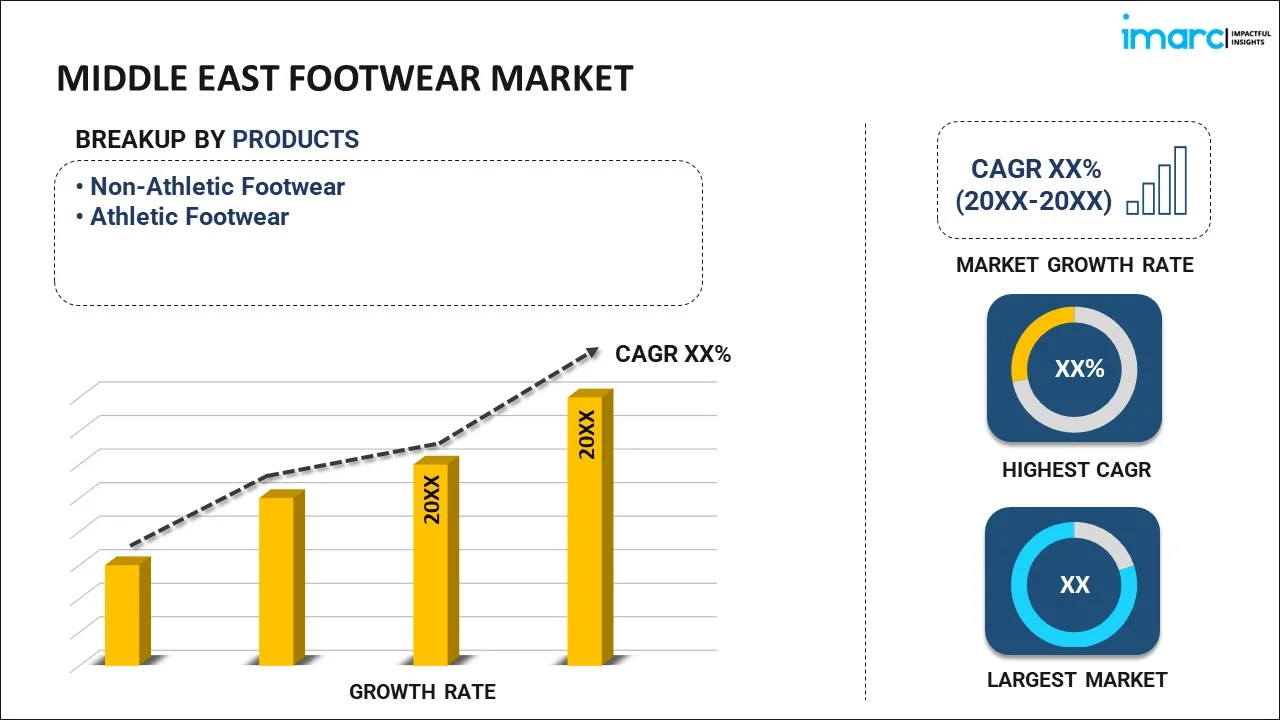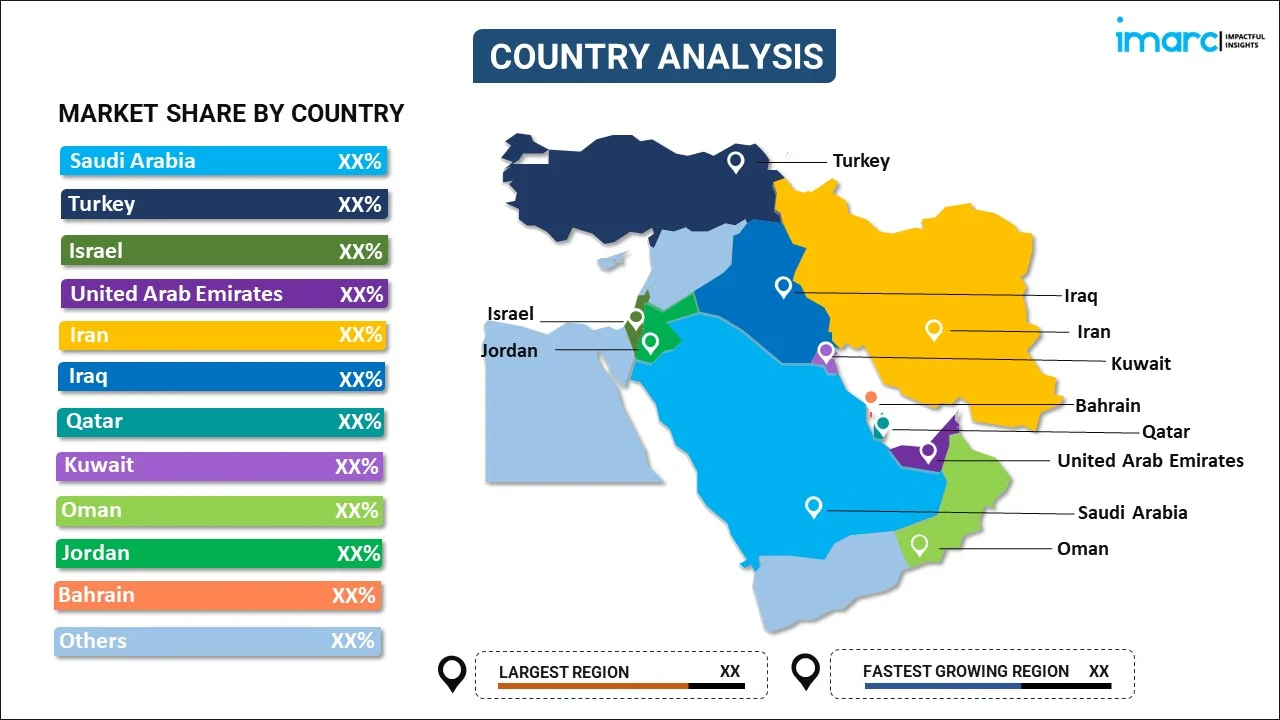
Middle East Footwear Market Report by Product (Non-Athletic Footwear, Athletic Footwear), Material (Rubber, Leather, Plastic, Fabric, and Others), Distribution Channel (Footwear Specialists, Supermarkets and Hypermarkets, Departmental Stores, Clothing Stores, Online Sales, and Others), Pricing (Premium, Mass), End User (Men, Women, Kids), and Country 2025-2033
Market Overview:
Middle East footwear market size reached USD 13.1 Billion in 2024. Looking forward, IMARC Group expects the market to reach USD 18.5 Billion by 2033, exhibiting a growth rate (CAGR) of 3.6% during 2025-2033. The growing consumer fashion consciousness, along with the introduction of innovative designs and features that offer more comfort, is primarily augmenting the regional market.
|
Report Attribute
|
Key Statistics
|
|---|---|
|
Base Year
|
2024
|
|
Forecast Years
|
2025-2033
|
|
Historical Years
|
2019-2024
|
|
Market Size in 2024
|
USD 13.1 Billion |
|
Market Forecast in 2033
|
USD 18.5 Billion |
| Market Growth Rate 2025-2033 | 3.6% |
Footwear serves the purpose of offering comfort and safeguarding the feet, encompassing items like shoes, boots, sandals, and slippers. These items are crafted from diverse materials like wood, canvas, leather, jute, plastics, and rubber. Beyond just shielding the feet and providing walking support, footwear serves as a means of expressing personal style and making a fashion statement. Moreover, it is designed for specific activities, both athletic and non-athletic, such as running, hiking, and working. Available in a broad spectrum of shapes, sizes, and colors, footwear can also be personalized with text, logos, and prints. Notably, it is environmentally friendly, easily decomposing without contributing to landfill waste or water pollution.
Middle East Footwear Market Trends:
The Middle East footwear market stands as a dynamic and rapidly evolving sector, reflecting the region's diverse cultural influences and economic growth. With a rich tapestry of traditions and styles, the market caters to a wide range of consumer preferences. Besides this, traditional craftsmanship coexists with modern design trends, offering a plethora of choices from intricately detailed handmade sandals to cutting-edge athletic shoes, which is positively influencing the regional market. Moreover, the demand for footwear in the Middle East is fueled not only by practical considerations of comfort and protection but also by a growing emphasis on fashion and personal expression. Apart from this, countries in the Middle East, such as the United Arab Emirates and Saudi Arabia, have witnessed a surge in urbanization and a burgeoning middle class, contributing to increased consumer spending on apparel and fashion accessories, including footwear. International brands alongside local manufacturers compete in this vibrant market, leveraging innovative materials and design concepts. Additionally, the region's focus on sports and fitness has driven a demand for specialized athletic footwear, reflecting a lifestyle shift towards health and wellness. As the country continues to embrace the emerging trends while preserving its cultural identity, the footwear market is expected to fuel over the forecasted period.
Middle East Footwear Market Segmentation:
IMARC Group provides an analysis of the key trends in each segment of the market, along with forecasts at the regional and country levels for 2025-2033. Our report has categorized the market based on product, material, distribution channel, pricing, and end user.
Product Insights:

- Non-Athletic Footwear
- Athletic Footwear
The report has provided a detailed breakup and analysis of the market based on the product. This includes non-athletic footwear and athletic footwear.
Material Insights:
- Rubber
- Leather
- Plastic
- Fabric
- Others
A detailed breakup and analysis of the market based on the material have also been provided in the report. This includes rubber, leather, plastic, fabric, and others.
Distribution Channel Insights:
- Footwear Specialists
- Supermarkets and Hypermarkets
- Departmental Stores
- Clothing Stores
- Online Sales
- Others
The report has provided a detailed breakup and analysis of the market based on the distribution channel. This includes footwear specialists, supermarkets and hypermarkets, departmental stores, clothing stores, online sales, and others.
Pricing Insights:
- Premium
- Mass
A detailed breakup and analysis of the market based on the pricing have also been provided in the report. This includes premium and mass.
End User Insights:
- Men
- Women
- Kids
The report has provided a detailed breakup and analysis of the market based on the end user. This includes men, women, and kids.
Country Insights:

- Saudi Arabia
- Turkey
- Israel
- United Arab Emirates
- Iran
- Iraq
- Qatar
- Kuwait
- Oman
- Jordan
- Bahrain
- Others
The report has also provided a comprehensive analysis of all the major regional markets, which include Saudi Arabia, Turkey, Israel, United Arab Emirates, Iran, Iraq, Qatar, Kuwait, Oman, Jordan, Bahrain, and Others.
Competitive Landscape:
The market research report has also provided a comprehensive analysis of the competitive landscape. Competitive analysis such as market structure, key player positioning, top winning strategies, competitive dashboard, and company evaluation quadrant has been covered in the report. Also, detailed profiles of all major companies have been provided.
Middle East Footwear Market Report Coverage:
| Report Features | Details |
|---|---|
| Base Year of the Analysis | 2024 |
| Historical Period | 2019-2024 |
| Forecast Period | 2025-2033 |
| Units | Billion USD |
| Scope of the Report | Exploration of Historical Trends and Market Outlook, Industry Catalysts and Challenges, Segment-Wise Historical and Future Market Assessment:
|
| Products Covered | Non-Athletic Footwear, Athletic Footwear |
| Materials Covered | Rubber, Leather, Plastic, Fabric, Others |
| Distribution Channels Covered | Footwear Specialists, Supermarkets and Hypermarkets, Departmental Stores, Clothing Stores, Online Sales, Others |
| Pricings Covered | Premium, Mass |
| End Users Covered | Men, Women, Kids |
| Countries Covered | Saudi Arabia, Turkey, Israel, United Arab Emirates, Iran, Iraq, Qatar, Kuwait, Oman, Jordan, Bahrain, Others |
| Customization Scope | 10% Free Customization |
| Post-Sale Analyst Support | 10-12 Weeks |
| Delivery Format | PDF and Excel through Email (We can also provide the editable version of the report in PPT/Word format on special request) |
Key Questions Answered in This Report:
- How has the Middle East footwear market performed so far and how will it perform in the coming years?
- What has been the impact of COVID-19 on the Middle East footwear market?
- What is the breakup of the Middle East footwear market on the basis of product?
- What is the breakup of the Middle East footwear market on the basis of material?
- What is the breakup of the Middle East footwear market on the basis of distribution channel?
- What is the breakup of the Middle East footwear market on the basis of pricing?
- What is the breakup of the Middle East footwear market on the basis of end user?
- What are the various stages in the value chain of the Middle East footwear market?
- What are the key driving factors and challenges in the Middle East footwear?
- What is the structure of the Middle East footwear market and who are the key players?
- What is the degree of competition in the Middle East footwear market?
Key Benefits for Stakeholders:
- IMARC’s industry report offers a comprehensive quantitative analysis of various market segments, historical and current market trends, market forecasts, and dynamics of the Middle East footwear market from 2019-2033.
- The research report provides the latest information on the market drivers, challenges, and opportunities in the Middle East footwear market.
- Porter's five forces analysis assist stakeholders in assessing the impact of new entrants, competitive rivalry, supplier power, buyer power, and the threat of substitution. It helps stakeholders to analyze the level of competition within the Middle East footwear industry and its attractiveness.
- Competitive landscape allows stakeholders to understand their competitive environment and provides an insight into the current positions of key players in the market.
Need more help?
- Speak to our experienced analysts for insights on the current market scenarios.
- Include additional segments and countries to customize the report as per your requirement.
- Gain an unparalleled competitive advantage in your domain by understanding how to utilize the report and positively impacting your operations and revenue.
- For further assistance, please connect with our analysts.
 Inquire Before Buying
Inquire Before Buying
 Speak to an Analyst
Speak to an Analyst
 Request Brochure
Request Brochure
 Request Customization
Request Customization




.webp)




.webp)












